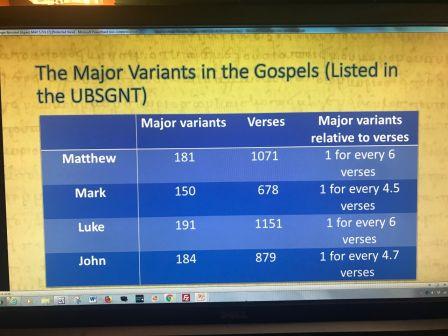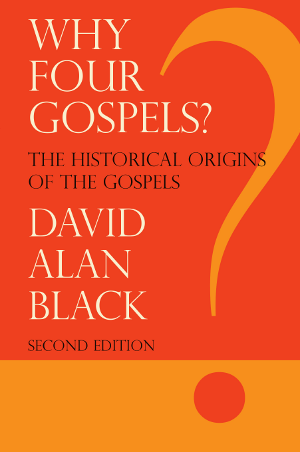(From Dave Black Online. Used by permission.)
11:48 AM Hello bloggers,
Sorry for posting so much about me of late. I think we all need a break from that, don’t you? So, to change the subject ….
The journal New Testament Studies has kindly been allowing access to several of its essays for free. I have been reading Graham Stanton’s “The Fourfold Gospel” with great interest, since I am a proponent of the “Fourfold Gospel Hypothesis.” (See my Why Four Gospels?) The essay, of course, assumes a commitment to the Markan Priority Hypothesis.
When Matthew wrote his Gospel, he did not intend to supplement Mark: his incorporation of most of Mark’s Gospel is surely an indication that he intended that his Gospel should replace Mark’s, and that it should become the Gospel for Christians of his day. Similarly Luke. Luke’s Preface should not be dismissed merely as the evangelist’s way of honouring literary convention. There is little doubt that Luke expects that his more complete Gospel will displace his predecessors, even though he may not intend to disparage their earlier efforts. Whether or not John knew of the existence of one or more of the synoptic gospels, he seems to have expected that his Gospel would win wide acceptance as the Gospel.
If I may be permitted a few random reflections …
I deeply appreciate Stanton’s tireless work in Gospel studies. However, as I have tried to show in my book, to understand how the four Gospels got to us, one needs to forget virtually everything that has been previously accepted as fact about the Synoptic Problem. The Fourfold Gospel Hypothesis does not allow readers to acquire a new idea that can be applied to their existing solution to the problem. Simply put, students of the Gospels cannot hold to the traditional solution of Markan Priority and accept the concepts that are put forth in Why Four Gospels? Let me elucidate:
1) The Markan Priority Hypothesis — which is the “affirmed” interpretation of history based almost exclusively on the internal evidence — is fatally flawed when one takes into account the writings of the earliest Christian fathers. Regrettably, any theory of New Testament interpretation, once it is established, becomes nearly impossible to dislodge, even if new (and seemingly contradictory) evidence is produced. Any new interpretation of the events, if it is to be accepted, must be built around the old consensus and incorporated into it, even at the expense of logic. An example of this is the Farrer Hypothesis, which dispenses with “Q” while insisting on Markan Priority. Indeed, so embedded is the popular view in the public consciousness that it is nearly impossible to dismiss it. The story is “safe,” and the matter is not really open to debate. In my opinion, New Testament scholarship has become so preoccupied with maintaining the status quo that it has neglected to explore the external evidence. Moreover, I think there is insufficient curiosity, generally speaking, as to why the Gospels were written in the first place.
2) As I have noted, the accepted version of the story focuses on the external evidence. If, however, one were to seriously investigate the external evidence — the evidence provided by the patristic testimony — it would become evident that current explanations are incongruent and incompatible with the opinions of the fathers. Why, for example, did Clement of Alexandria insist that the Gospels “containing the genealogies” (i.e., Matthew and Luke) were written first? And why is Matthew always listed as the first Gospel? Why is Mark’s Gospel consistently described not as an independent work of Mark but as a record of the words of the apostle Peter? In light of this evidence, it seems illogical to believe that our earliest Gospel was written by Mark, a non-eyewitness.
3) Ensconced deeply in the affirmed version is the notion that Mark contains inferior grammar to that found in Matthew and Luke. Some Markan priorists have even gone so far as to claim that Mark contains “errors” that were subsequently “corrected” by Matthew and Luke. Yet each of these supposed “errors” allows for a plausible alternative explanation that does not require Markan priority (as I have attempted to show here). If the New Testament student desires a complete understanding of the factors that led up to the writing of the Gospels, the internal evidence alone simply does not provide it. The external evidence keeps getting in the way of the affirmed version.
4) Again, why are the fathers so adamant that Matthew came first? Why did Clement aver that Matthew and Luke came before Mark? Why do the fathers go to great lengths to show that Mark never set out to write a Gospel but simply recorded the words of Peter as they were spoken before his Roman audience? What has prevented proponents of the affirmed view from asking these vital questions? The answer, in my opinion, is that the consensus view is falsely shackled to a misguided preference for the internal evidence. In short (and this post is already way too long!), as long as the patristic testimony is ignored, the internal evidence, which by its very nature is subjective, will continue to reign supreme. And as long as the traditional view is anchored in the minds of scholars, the solution will remind hidden.
So what is the simplest explanation of the facts — all the facts? To discover that, one must be bold. The missing pieces of the puzzle must be included if we are to assemble the whole puzzle rather than leaving them out because they do not seem to fit. Taking the external evidence into account will have serious repercussions. The answer to the Synoptic Problem will remind incomplete until a central piece of the puzzle is in place.
Think about it 🙂
Dave


One Comment
Comments are closed.